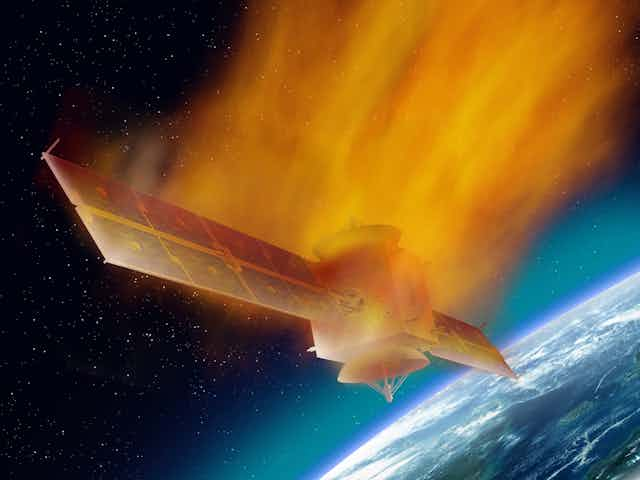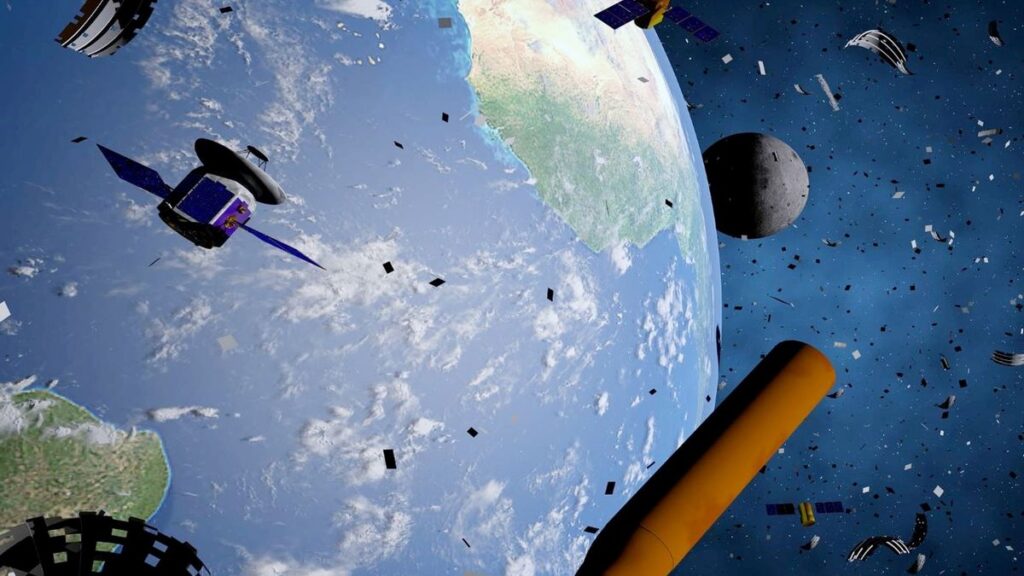
Elon Musk’s SpaceX has reported it will discard 100 Starlink satellites throughout the following a half year, after it found a plan imperfection that might make them fall flat. As opposed to gamble with representing a danger to other space apparatus, SpaceX will “de-circle” these satellites to wreck in the environment.
Yet, barometrical researchers are progressively worried that this kind of clear fly-tipping by the space area will create additional environmental change down on The planet. One group as of late, and out of the blue, found potential ozone-exhausting metals from space apparatus in the stratosphere, the climatic layer where the ozone layer is shaped.
The family member “low earth circle” where satellites observing Earth’s environments are found is progressively clogged – Starlink alone has in excess of 5,000 shuttle in circle. Clearing flotsam and jetsam is thusly fundamentally important for the space area. Recently sent off shuttle should likewise be taken out from circle in the span of 25 years (the US as of late executed a stricter five-year rule) either by moving upwards to a purported “burial ground circle” or down into the World’s climate.
Lower circling satellites are generally intended to utilize any leftover fuel and the draw of the World’s gravity to reemerge the air. In a controlled reemergence, the rocket enters the environment at a pre-set opportunity to land in the most remote piece of the Pacific Sea at Point Nemo (otherwise known as the shuttle graveyard). In an uncontrolled reemergence, shuttle are left to follow a “characteristic downfall” and wreck in the air.
Nasa and the European Space Organization advance this type of removal as a component of a plan reasoning called “plan for downfall”. It is a natural test to fabricate, send off and work a satellite strong enough to work in the antagonism of room yet likewise ready to separate and catch fire effectively on reemergence to keep away from risky trash arriving at the World’s surface. It’s as yet a work underway.
Satellite administrators should demonstrate their plan and reemergence plans have a low “human-hit” rate before they are granted a permit. However, there is restricted concern in regards to the effect on Earth’s upper climate during the reemergence stage. This isn’t an oversight.
ALSO READ | Gta-6-trailer-2-expected-to-premiere-soon-generating-unprecedented-excitement-in-gaming-community-report
At first, neither the space area nor the astronomy local area thought about consuming satellites on reemergence to be a serious ecological danger – to the environment, in any event. All things considered, the quantity of space apparatus particles delivered is little when contrasted and 440 tons of meteoroids that enter the air everyday, alongside volcanic debris and human-made contamination from modern cycles

Table of Contents
ToggleIs the Ozone Layer Facing Bad News?
So are air environment researchers blowing up to the presence of shuttle particles in the air? Their interests bring on 40 years of examination into the reason for the ozone openings over the south and north poles, that were first generally seen during the 1980s.
Today, they currently realize that ozone misfortune is brought about by human-made modern gases, which consolidate with regular and exceptionally high height polar stratospheric mists or mother of pearl mists.
The surfaces of these ethereal mists go about as impetuses, transforming harmless synthetics into additional dynamic structures that can quickly annihilate ozone.
Dan Cziczo is an air researcher at Purdue College in the US, and a co-creator of the new review that found ozone draining substances in the stratosphere. He makes sense of for me that the inquiry is whether the new particles from space apparatus will help the development of these mists and lead to ozone misfortune when the World’s climate is simply starting to recuperate.
Of more worry to air researchers, for example, Cziczo is that a couple of new particles could make a greater amount of these sorts of polar mists – at the upper air, yet additionally in the lower climate, where cirrus mists structure. Cirrus mists are the slim, wispy ice mists you could detect high overhead, over six kilometers. They will generally let heat from the sun go through however at that point trap it on the exit plan, so in principle more cirrus mists could include extra a worldwide temperature alteration top of what we are as of now seeing from ozone depleting substances. In any case, this is dubious yet being considered.
Cziczo additionally makes sense of that from episodic proof we realize that the high-height mists over the shafts are changing – yet we don’t have any idea yet the thing is causing this change. Is it regular particles like meteoroids or volcanic garbage, or unnatural particles from rockets? This is the thing we want to be aware.

Worried, Yet Uncertain
So how would we respond to this question? We have some exploration from air researchers, space apparatus developers and astrophysicists, however it’s not thorough or zeroed in to the point of settling on informed choices on which bearing to take.
A few astrophysicists guarantee that alumina (aluminum oxide) particles from space apparatus will cause substance responses in the environment that will probably set off ozone obliteration.
Climatic researchers who concentrate on this subject exhaustively have not taken this leap as there isn’t sufficient logical proof. We know particles from rocket are in the stratosphere. Be that as it may, how this affects the ozone layer or the environment is as yet unclear.
It is enticing to exaggerate research discoveries to collect more help. Be that as it may, this is the way to investigate damnation – and deniers will utilize unfortunate discoveries sometime in the not too distant future to ruin the exploration. We likewise don’t have any desire to utilize egalitarian conclusions. In any case, we’ve additionally discovered that assuming that we hold on until undeniable proof is accessible, it could be past the point of no return, likewise with the deficiency of ozone. It’s a steady problem.
How will satellite debris affect our planet and us?@UBCphas Dr. Aaron Boley says aluminum oxide, a product of satellites burning in the atmosphere, could damage the ozone layer and affect the Earth’s climate.
— UBC Media Relations (@UBCNews) October 19, 2023
via @SPACEdotcom https://t.co/jXgTiRkW9u
FaQ section
some of its Starlink satellites?
SpaceX is planning to de-orbit 100 Starlink satellites over the next six months due to a design flaw that could cause them to fail.
Why is SpaceX choosing to de-orbit these satellites?
SpaceX wants to avoid the risk of these satellites posing a threat to other space apparatus by de-orbiting them.
What concerns are atmospheric scientists raising regarding the de-orbiting of satellites?
Atmospheric scientists are concerned that the de-orbiting of satellites could contribute to additional climate change on Earth.
What did a recent study find in the stratosphere related to space apparatus?
A recent study found potential ozone-depleting metals from space apparatus in the stratosphere.
What is the purpose of de-orbiting satellites in the space industry?
De-orbiting satellites is crucial for clearing debris from Earth’s orbit and ensuring space sustainability.
What is the principle behind controlled re-entry of satellites into Earth’s atmosphere?
Controlled re-entry involves satellites entering the atmosphere at a pre-set time to land in a designated area, such as the Pacific Ocean.
Why is there concern about the impact of burning satellites on Earth’s upper atmosphere?
Concerns arise due to the potential influence of satellite particles on cloud formation and ozone depletion in the upper atmosphere.
What are cirrus clouds, and why are they relevant to climate change?
Cirrus clouds are thin, wispy ice clouds that can trap heat, potentially contributing to global warming if their coverage increases.
What are some theories regarding changes observed in high-altitude clouds over the poles?
Changes in high-altitude clouds over the poles could be attributed to natural particles like meteoroids or volcanic debris, as well as artificial particles from rockets.
What is the current state of scientific understanding regarding the impact of satellite particles on the ozone layer?
While there is evidence of satellite particles in the stratosphere, the exact impact on the ozone layer and the atmosphere remains uncertain and requires further research.



One thought on “Unanswered Questions: Satellites Burning Up in Upper Atmosphere and Their Potential Impact on Earth’s Climate”